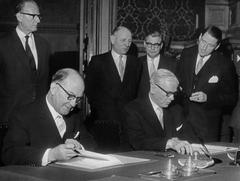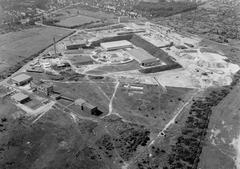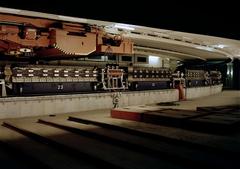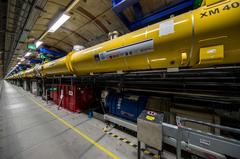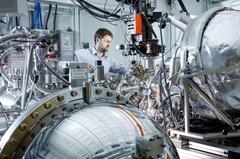Part of the DESY staff in Hamburg holds the DESY-60 logo (photo: DESY/H. Müller-Elsner).
The story of DESY began on 18 December 1959 with the signing of a contract in Hamburg’s town hall. It is a story of success, for global research and for Germany as a science hub! For the past 60 years, fundamental research has been carried out at DESY in Hamburg-Bahrenfeld – which was joined in 1991 by a second DESY site in Zeuthen. In those 60 years, DESY has become a world leader in accelerator technology, structure research, particle physics and astroparticle physics. During these 60 years, DESY has developed pioneering technologies, which have been used by scientists from all over the world to make outstanding advances. Among other things, the gluon was discovered and the structure of ribosomes was determined at DESY.
“It is now a question of the big challenges of our times,” says DESY’s director Professor Helmut Dosch. “We have developed a new generation of research tools in the form of so-called X-ray lasers. These afford fundamental insights in medicine and in materials engineering, for example, which will help shape the world of tomorrow.” DESY offers unique conditions for this: the combination of the radiation sources PETRA III, FLASH and European XFEL means that international scientists can carry out experiments using high-intensity X-rays. In addition to this, DESY offers structure researchers and businesses from all over the world a unique “toolbox” in the form of supplementary methods for manufacturing, processing and examining nano-samples and nanomaterials. DESY’s second site in Zeuthen is also an international magnet as a growing centre of excellence in astroparticle physics. Zeuthen operates the only accelerator in Brandenburg and is one of the largest scientific institutions in the region.
Building upon six decades of experience, DESY is excellently placed to tackle the global challenges of the future: “We bring together strong national and international research partners, and create the necessary conditions for innovation in important areas such as energy supply, medicine and new technologies,” says Helmut Dosch. The most recent examples of this are the Innovation Centre for DESY start-ups and the Centre for X-Ray and Nanoscience CXNS, which among other things will be developing new materials from 2021 onwards. Both buildings are currently under construction at the Hamburg DESY campus, which is in fact to become the germ cell for a new science district, known as Science City Bahrenfeld. In just a few years’ time, top-class DESY research carried out there in collaboration with the natural science faculties at Hamburg University will be providing a powerful stimulus for business and society.
Some special events are planned for the anniversary year, to celebrate 60 years of DESY. These will kick off with a festive reception to be held by the Hamburg Senate on 16 January 2020, an event that is being hosted by the Deputy Mayor and Senator for Science, Katharina Fegebank.
January will also see the start of “Wir wollen’s wissen!” (We want to know!), a joint project by DESY and the University of Hamburg: from 20 to 24 January, researchers at DESY and their colleagues from the university will visit Hamburg schools and explain the world of science in ways that are fun and appropriate for children. Also in January, a special issue of the DESY research magazine “femto” will be released, competently and compactly summarising the past 60 years of research. In a new round of the successful lecture series “Wissen vom Fass” (Science on tap), another joint project by DESY and Hamburg University, DESY experts will once again be explaining scientific topics in an easily comprehensible way in the bars of Hamburg pubs and taverns on 23 April 2020.
In the spring, the DESY Science Photowalk 2020 will open up entirely new vistas, allowing amateur photographers to take their own look around the world of science at DESY in Hamburg and Zeuthen. DESY’s communications offensive during the anniversary year will also include talks and debates on issues such as women in science, ethics and research, and the science hub Hamburg/Science City Bahrenfeld. Finally, on 20 June 2020, DESY will be inviting visitors to attend an open day on the campus in Hamburg-Bahrenfeld, entitled DESY60 DAY.
6 x DESY60 - Facts, figures and milestones on DESY’s 60th birthday
DESY in numbers
2662: employees hailing from 77 countries
3000: international guest researchers per year from more than 40 countries
295: buildings on DESY’s Hamburg premises, including tunnels
10 000: visitors taking part in public tours of DESY every year
9900: school pupils who conducted experiments in DESY’s school laboratories in 2019
2023: the year in which DESY’s new visitors’ centre DESYUM is due to be completed
DESY in scientific numbers
16 288 metres: total length of all the accelerator tunnels
1.8 nanograms: approximate amount of antimatter that DESY has produced for its experiments in the form of positrons since it first started operating. To amass the famous gram of antimatter mentioned in the film “Angels & Demons”, DESY would need to continue producing antimatter for another 33 billion years.
1 cubic kilometre: The size of the biggest detector on which DESY is currently collaborating. This is the IceCube neutrino detector, at the South Pole, which is looking for “ghost particles” using more than 5000 light sensors frozen into the Antarctic ice.
1.9 femtoseconds (trillionths of a second): The shortest pulse of UV laser light in the world, which was produced this year at DESY.
100 micrometres: For experiments to work, the individual components have to be aligned to within a tenth of a millimetre (100 micrometres) along the kilometre-long particle accelerators.
0: the number of black holes that have ever been produced in DESY accelerators.
Six unusual facts about DESY
Time travel: Thousands of years before DESY arrived in Hamburg Bahrenfeld, a Stone Age village stood on the same site. A warrior’s grave was located on the very spot where the DESY Board of Directors now has its offices. This megalithic barrow was removed in 1934. Only the name of a street still reminds locals of its existence.
Female: DESY, DORIS, HERA, PETRA, PIA – all the ring accelerators at DESY have women’s names. All of them are abbreviations for scientific functions and terms. For example: PETRA = Positron-Electron Tandem Ring Accelerator.
Early bird: The first website in Germany, http://apollo3.desy.de, went online in September 1992 at DESY. It was programmed by an IT employee – who still works at DESY.
DESY film set: The film “Panische Zeiten” (1979) with Udo Lindenberg was shot on DESY’s grounds. Inquiries have also been received from Hollywood.
Circumspect: The climbing tower in Hamburg’s Volkspark used to be DESY’s surveying tower for the 6.3 kilometre long particle accelerator HERA. All four experimental halls could be seen from there and their positions could be measured to within a millimetre.
Clean! DESY’s scientists fear for their sensitive equipment, so in some labs they prefer to do their own cleaning .
Six spectacular facts about DESY
Chilly: The accelerator modules for the free-electron lasers FLASH and European XFEL run at an operating temperature of minus 271 degrees Celsius – two degrees above absolute zero. This is colder than outer space (‑270.42 degrees).
Sensitive: The light detector for the ALPS experiment, which is searching for very light particles of dark matter, is so sensitive that it could spot a 100-watt light source at a distance of 10 million kilometres – corresponding to a lightbulb at 25 times the distance to the Moon.
Sensitive II: The GRAVI experiment, in which DESY is measuring the gravitational constant, is so sensitive that it has even detected earthquakes in China.
Superfast: The free-electron laser FLASH made it into the Guinness Book of Records in 2012 with the “fastest film in the world”. The individual images were separated by intervals of just 50 femtoseconds (trillionths of a second) – 800 billion times the speed of a normal cinema film.
X-ray vision: In 2008, scientists at DESY revealed a Van Gogh that had been painted over. After two days of intense scrutiny using synchrotron radiation from the DORIS accelerator, a woman’s portrait came to light beneath a green meadow.
Single slab: The longest slab of concrete ever poured in a single piece is the low-vibration floor of the largest experimental hall at PETRA III. Its dimensions: one metre thick, 24 metres wide and almost 280 metres long.
Six DESY milestones in 60 years
18 December 1959: The state treaty establishing “Deutsches Elektronen-Synchrotron” is signed in Hamburg’s town hall. Just five years later, electrons are racing down the “original accelerator”, which also goes by the name of DESY. The first spectacular achievement: in 1965, scientists at DESY succeed in creating an antiproton.
1974: Setting out into new realms of research: DESY starts operating DORIS, a new type of accelerator that can be used not only for particle physics, but also as a particularly bright source of radiation. In 1978, HASYLAB is set up, a large laboratory for conducting research using this so-called synchrotron radiation. It quickly becomes one of the leading facilities of its type in the world. In 2009, the scientist Ada Yonath is awarded the Nobel Prize in Chemistry for her persistent study of biomolecules, much of which took place at DORIS.
In 1978, DESY starts up PETRA, the largest storage ring in the world at the time (2.3 kilometres). Ground-breaking: in 1979, the gluon, a particle that causes quarks to stick together, is discovered here! It provides an important answer to the great question what holds the world together deep down inside, and is to this day the biggest discovery in particle physics ever made at DESY.
In 1990, HERA goes into operation, DESY’s largest accelerator (6.3 kilometres). HERA is the only place in the world where electrons and protons are made to collide with each other. HERA is used to unravel the complex structure of the proton.
In 1991, Zeuthen near Berlin becomes DESY’s second site. Back in the days before German reunification, researchers working at the Institute of High-Energy Physics in Zeuthen collaborated in DESY’s experiments in Hamburg. Today, Zeuthen is most of all a centre of excellence for astroparticle physics and home to the only particle accelerator in Brandenburg .
2017: With the launch of the super-laser European XFEL, which produces ultrashort X-ray laser pulses, Hamburg becomes the world capital of X-ray research, once and for all. FLASH was launched back in 2004, and the storage ring PETRA III has been one of the world’s best sources of synchrotron radiation since 2010. DESY offers research opportunities in this field that are not found anywhere else in the world.









